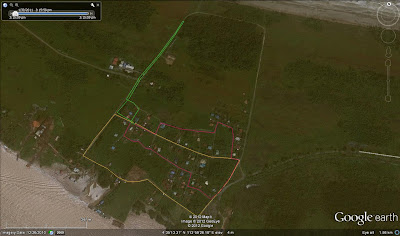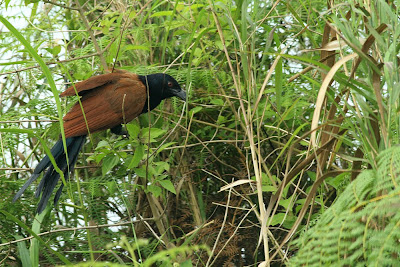
Little Egret in it's elements. Beauty simplified.


Some people wouldn't mind paying to be able to enjoy this kind of serenity on a daily basis, I'm thankful for being able to consider it as my backyard. If only the powers that be would consider keeping this patch of salt intruded piece of wasteland as a signature wetland for Kuala Baram it'll be heaven sent. We'll just leave it as is, built a few pondok around the area with information panels on the wildlife common in the area. Recruit volunteers from the local community to give guided tours, organise outreach activities for locals and visitors alike ... it'll be perfect indeed.
Birdlist :

"Air yang tenang jangan di sangka tiada buaya!", as the saying goes but I haven't spotted any of the reptilians so far. The locals we spoke to are more than sure that there are indeed crocodiles in these waters ... we are in Sarawak afterall, this water body is directly connected to the South China Sea not 15mins walk away. The Indonesian workers nearby have sworn to have seen the crocs with their own eyes. More the better ...
Sanderling by the beach.
A lone Little Egret ... actually there was also a Chinese Egret in front of this guy but flew away before any photo was taken. We've recorded Pacific Reef Egret and Great Egret here as well over the years.
We counted 30 Wandering Whistling Ducks that morning. This patch could be another favorite hanging out spot for the ducks which we have not considered previously since it's so close to the sea. Last Feb some kampong children collected 10 ducklings crossing the swamp hoping they could rear them as pets, unfortunately the ducklings all died one by one. As to how the ducklings got the road in the first place was another question that remained unanswered.
Participants: Nazeri, Sara, Ali and Aisya
We started about 0800 hrs and stopped approximately 1030 hrs. We've been to this place countless time but have not quite gotten tired of it. It's probably one of the nicest place in Miri to visit very early in morning to just watch the mist lift up from the ground and see birds flying overhead across a deep blueskies day.
Though lately across the road towards ASEAN Bridge there've been a lot of activity by Linau Mewah (SY subsidiary planting palm oil, tree plantation for pulp and paper); this side of the road has been relatively quiet with the occasional rod and reel fishermen from Miri and Brunei trying their luck with the fishies here.
The birds so far seemed unperturbed. However, the nesting raptors were the first to go ... when they cleared the land and took down all the remaining tall trees in the open peatswamp across the road. The victims included Changeable Hawk Eagle, White-bellied Sea Eagle and the latest was Grey-headed Fish Eagle which we recorded here and later here. There isn't a tall nesting tree left standing in the newly opened area.
Though lately across the road towards ASEAN Bridge there've been a lot of activity by Linau Mewah (SY subsidiary planting palm oil, tree plantation for pulp and paper); this side of the road has been relatively quiet with the occasional rod and reel fishermen from Miri and Brunei trying their luck with the fishies here.
The birds so far seemed unperturbed. However, the nesting raptors were the first to go ... when they cleared the land and took down all the remaining tall trees in the open peatswamp across the road. The victims included Changeable Hawk Eagle, White-bellied Sea Eagle and the latest was Grey-headed Fish Eagle which we recorded here and later here. There isn't a tall nesting tree left standing in the newly opened area.
The bee-eaters, kingfishers, snipes, rails, egrets, grassbirds and others are as happy feeding and foraging on the quieter side of the swamp. The shorebirds used the ponds as roosting sites when in season. Oriental Darter and Purple Heron are occasionally seen foraging in the shallows. Collared Kingfishers and White-breasted Woodswallows nest here. Pied Triller is another bird found in abundance.
Sunset here on a good evening can't be beat by any sunset at any other place ... you just have to run for cover as quickly as you can after the sun goes down on account of the mosquitoes, they are ferocious here ... they start right after sundown all tge way to 0630hrs the next morning, no breaks. Camping only advisable if you plan to put up a big bonfire.
For our AWC for this year we made a loop passing SY Prawn Farm to be beach through the little kampong with scattered houses and back the same route. Most birds were observed at the far end of the ponds. It would be a good idea to come back and stake out that part of the beach. We recorded 30 ducks in the vicinity.
Looking at the map of the area, the place seems seasonably wet. Another good activity is to perhaps explore further north towards Sg Tujuh, there's a small patch of forest still standing amidst the wetlands ... who knows what wildlife lurks within.
6 Grey Heron
15 Intermediate Egret
20 Cattle Egret
10 Great Egret
10 Little Egret
30 Pacific Golden Plover
1 pair Malaysian Plover
5 Greater Sand Plover
5 Sanderling
1 Chinese Egret
30 Wandering Whistling Duck
2 Common Kingfisher
10 Collared Kingfisher
5 Dollarbird
10 Blue-throated Bee Eater
5 Striated Grassbird
1 Brown Shrike
10 White-breasted Waterhen
Yellow-bellied Prinia
Oriental Reed Warbler
Striated Heron
Yellow Bittern
Chestnut Munia
Dusky Munia
Olive-back Sunbird
Common Iora
Pied Triller
Pied Fantail
Spotted Dove
Zebra Dove
White-breasted Woodswallow

The layout of the SY Prawn Farms, we used to get access from the Indonesian workers, these days it's a bird more tricky now that a local supervisor is there almost daily. We still manage to birdwatch around the perimeter of his property. Our next stake-out activity will be to drive onto the beach via Kpg Masjid and camp on the beach opposite the last pond (green cast) observe the waterbirds. So far we've recorded Peregrine Falcon, White-bellied Sea Eagle (nesting), Osprey, Grey-headed Fish Eagle (nesting), Changeable Hawk Eagle (nesting) and Oriental Darter in this area. Another to do activity here is to trace the old Kpg Masjid-Sg Tujuh walking paths used by villagers prior to the arrival of modern roads.
Images and Text by Nazeri Abghani/MNS Miri/Feb 2012




































